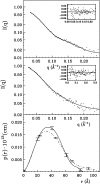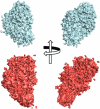Structural resolution of the complex between a fungal polygalacturonase and a plant polygalacturonase-inhibiting protein by small-angle X-ray scattering
- PMID: 21859985
- PMCID: PMC3192570
- DOI: 10.1104/pp.111.181057
Structural resolution of the complex between a fungal polygalacturonase and a plant polygalacturonase-inhibiting protein by small-angle X-ray scattering
Abstract
We report here the low-resolution structure of the complex formed by the endo-polygalacturonase from Fusarium phyllophilum and one of the polygalacturonase-inhibiting protein from Phaseolus vulgaris after chemical cross-linking as determined by small-angle x-ray scattering analysis. The inhibitor engages its concave surface of the leucine-rich repeat domain with the enzyme. Both sides of the enzyme active site cleft interact with the inhibitor, accounting for the competitive mechanism of inhibition observed. The structure is in agreement with previous site-directed mutagenesis data and has been further validated with structure-guided mutations and subsequent assay of the inhibitory activity. The structure of the complex may help the design of inhibitors with improved or new recognition capabilities to be used for crop protection.
Figures







Similar articles
-
A single amino-acid substitution allows endo-polygalacturonase of Fusarium verticillioides to acquire recognition by PGIP2 from Phaseolus vulgaris.PLoS One. 2013 Nov 19;8(11):e80610. doi: 10.1371/journal.pone.0080610. eCollection 2013. PLoS One. 2013. PMID: 24260434 Free PMC article.
-
Three aspartic acid residues of polygalacturonase-inhibiting protein (PGIP) from Phaseolus vulgaris are critical for inhibition of Fusarium phyllophilum PG.Plant Biol (Stuttg). 2009 Sep;11(5):738-43. doi: 10.1111/j.1438-8677.2008.00175.x. Plant Biol (Stuttg). 2009. PMID: 19689781
-
Structural requirements of endopolygalacturonase for the interaction with PGIP (polygalacturonase-inhibiting protein).Proc Natl Acad Sci U S A. 2001 Nov 6;98(23):13425-30. doi: 10.1073/pnas.231473698. Epub 2001 Oct 30. Proc Natl Acad Sci U S A. 2001. PMID: 11687632 Free PMC article.
-
Polygalacturonase-inhibiting protein (PGIP) in plant defence: a structural view.Phytochemistry. 2006 Mar;67(6):528-33. doi: 10.1016/j.phytochem.2005.12.025. Epub 2006 Feb 3. Phytochemistry. 2006. PMID: 16458942 Review.
-
Polygalacturonase-inhibiting proteins in defense against phytopathogenic fungi.Curr Opin Plant Biol. 2002 Aug;5(4):295-9. doi: 10.1016/s1369-5266(02)00271-6. Curr Opin Plant Biol. 2002. PMID: 12179962 Review.
Cited by
-
A phage display-selected peptide inhibitor of Agrobacterium vitis polygalacturonase.Mol Plant Pathol. 2016 May;17(4):480-6. doi: 10.1111/mpp.12293. Epub 2015 Sep 18. Mol Plant Pathol. 2016. PMID: 26177065 Free PMC article.
-
The pgip family in soybean and three other legume species: evidence for a birth-and-death model of evolution.BMC Plant Biol. 2014 Jul 18;14:189. doi: 10.1186/s12870-014-0189-3. BMC Plant Biol. 2014. PMID: 25034494 Free PMC article.
-
Homogalacturonan-modifying enzymes: structure, expression, and roles in plants.J Exp Bot. 2014 Oct;65(18):5125-60. doi: 10.1093/jxb/eru272. Epub 2014 Jul 23. J Exp Bot. 2014. PMID: 25056773 Free PMC article. Review.
-
Amino acid substitutions in a polygalacturonase inhibiting protein (OsPGIP2) increases sheath blight resistance in rice.Rice (N Y). 2019 Jul 29;12(1):56. doi: 10.1186/s12284-019-0318-6. Rice (N Y). 2019. PMID: 31359264 Free PMC article.
-
An update on polygalacturonase-inhibiting protein (PGIP), a leucine-rich repeat protein that protects crop plants against pathogens.Front Plant Sci. 2015 Mar 20;6:146. doi: 10.3389/fpls.2015.00146. eCollection 2015. Front Plant Sci. 2015. PMID: 25852708 Free PMC article. Review.
References
-
- Bent AF, Mackey D. (2007) Elicitors, effectors, and R genes: the new paradigm and a lifetime supply of questions. Annu Rev Phytopathol 45: 399–436 - PubMed
-
- Boller T, Felix G. (2009) A renaissance of elicitors: perception of microbe-associated molecular patterns and danger signals by pattern-recognition receptors. Annu Rev Plant Biol 60: 379–406 - PubMed
-
- Bonivento D, Pontiggia D, Di Matteo A, Fernandez-Recio J, Salvi G, Tsernoglou D, Cervone F, Lorenzo GD, Federici L. (2008) Crystal structure of the endopolygalacturonase from the phytopathogenic fungus Colletotrichum lupini and its interaction with polygalacturonase-inhibiting proteins. Proteins 70: 294–299 - PubMed
Publication types
MeSH terms
Substances
Grants and funding
LinkOut - more resources
Full Text Sources

